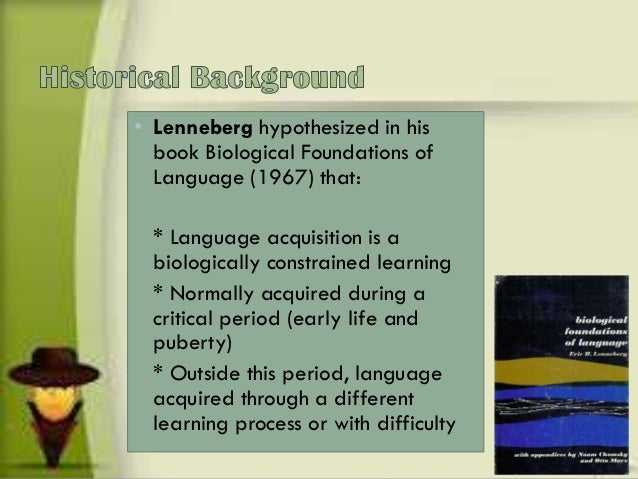Biological Foundations Of Language Lenneberg
Eric Heinz Lenneberg (19 September 1921 – 31 May 1975) was a and who pioneered ideas on and, particularly in terms of the concept of innateness.He was born in, Germany. Ethnically, he left because of rising. He initially fled to Brazil with his family and then to the United States where he attended the.
A professor of and, he taught at the, the in Ann Arbor and and Medical School.Lenneberg's 1964 paper 'The Capacity of Language Acquisition,' originally published in 1960, sets forth seminal arguments about the human-specific biological capacity for language, which were then being developed in his research and discussions with, and others at and, and popularized by in his book,. He presents four arguments for biological innateness of psychological capacities, parallel to arguments in biology for the innateness of physical traits:. Universal appearance of a trait at a single time across a species. 'Species typical' traits. Universal appearance across time for a group. Not just an artifact of cultural history.
Again, 'species typical' diagnostic feature. No learning of the trait is possible. Individual development of a trait rigidly follows a given schedule regardless of the particular experience of the organism.In his publication Biological Foundations of Language he advanced the of a for language development; a topic which remains controversial and the subject of debate.
Lenneberg's biological approach to language was related to developments such as the developed by and colleagues at and also provided historical antecedents to issues now emerging in and.Lenneberg reargued extensively against the psychological implications of the work of and, specifically in regards to the. Lenneberg's argument against this notion was that 'linguistic and non-linguistic events must be separately observed and described before they can be correlated.' . Phipps, Stacy. Language and Thought: Examining Linguistic Relativity.
Carroll, John (ed.) 1956. Language, Thought and Reality: Selected writings of Benjamin Lee Whorf. Massachusetts Institute of Technology. Neisser, U., Tapper, D., Gibson,E.J.
Lenneberg, Cornell University Faculty Memorial Statement. )Bibliography. Biological Foundations of Language. New York: John Wiley & Sons, 1967.

The Capacity of Language Acquisition in Fodor and Katz, 1964. Fodor, Jerry and Jerrold Katz, eds. 1964. The Structure of Language. Englewood Cliffs, NJ: Prentice Hall.
Noam Chomsky
The Fodor & Katz volume is a collection of papers around early Chomskyan linguistics, phonology, grammar, semantics.
Article citationsLenneberg, E. Biological Foundations of Language. New York: Wiley.has been cited by the following article:.TITLE:AUTHORS:KEYWORDS:,JOURNAL NAME:,March31,2015ABSTRACT: Language is a specifically human mental function, although some neurobiological adaptations associated with communication can be found in other primates, in other mammalian orders, and even in other kinds of animals (evolutionary trend). Exposure to language is necessary for its acquisition (culture), there are specific alleles of some genes for human language (gene), and the brain circuits for language are mainly lateralized towards the left hemisphere (brain lateralization). However, some data suggest that the crucial factor for human verbal language, which originates in childhood in both, ontogeny and phylogeny, must be of motivational nature, and have at least the same importance as other genetic, brain or cultural factors.
Biological Foundations Of Language Lenneberg
So, this article proposes that language was promoted by the building of love, and that it was maintained by hominid women as proto-language during some hundreds of thousands years through the maternal-filial interaction, until the first permanent settlements of the current human species, between 40,000-10,000 years ago. Also, that it was then when the woman transmitted speech to the man (it is further suggested that this may have been the Original Sin of the biblical Genesis), signalizing this transmission with the beginning of the symbolic thought, thus promoting the first artistic displays, like sculptures, painting or music, which were associated with the expansion of love and speech to the relationship between the sexes, with the consequent diversification of languages, mainly in the last 10,000 to 5,000 years. Love caused and causes human speech in both, phylogeny and ontogeny.